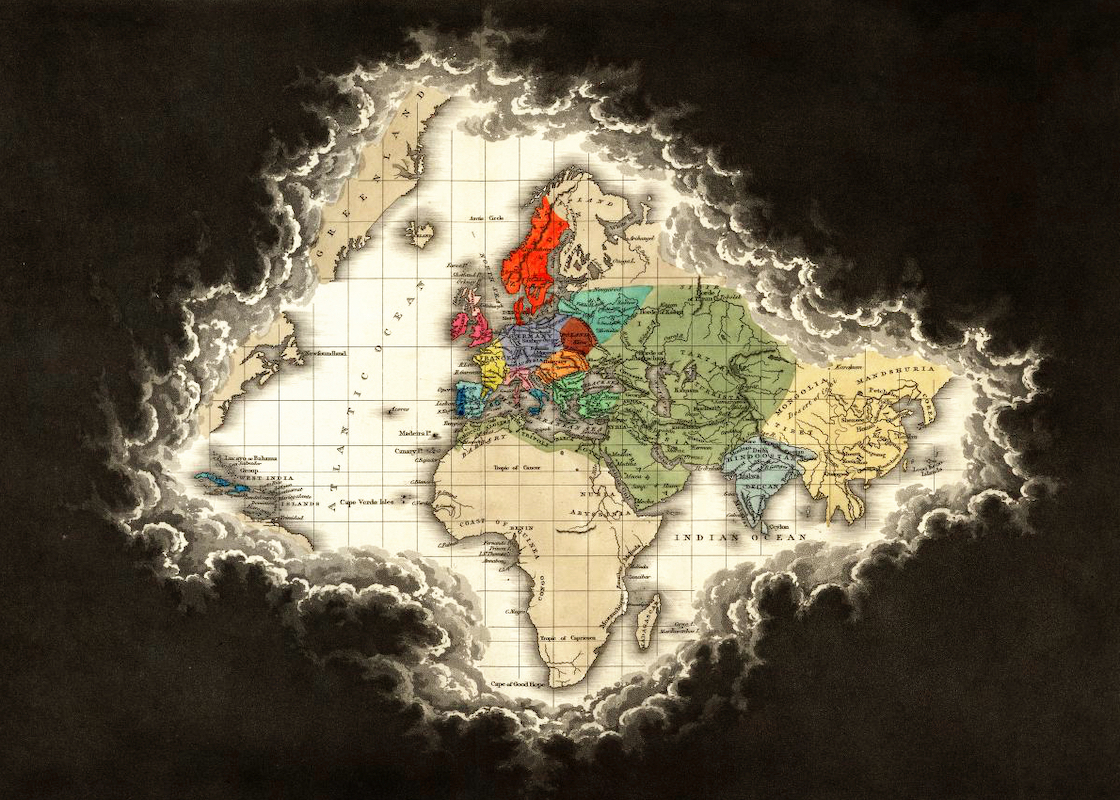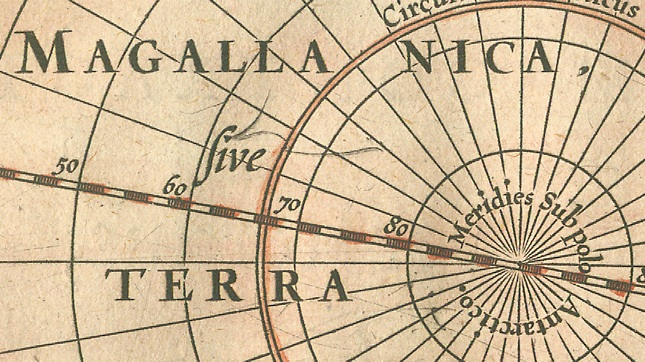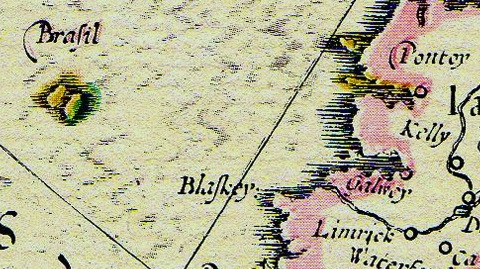Sandy Island, the Last Island to be Un-Discovered

In 2012, the world lost an island, and gained a phantom island. Losing islands is a regrettable, but increasingly common occurrence [1], what with rising sea levels and all. Gaining a phantom island, on the other hand, is an exciting event – especially since that particular category was considered extinct. Map-lovers were under the assumption that scientific rigour and satellite technology had illuminated the shadows out of the cartographic twilight in which phantom islands thrive. The Age of Un-Discovery had been closed for good, we thought. We thought wrong.
A phantom island can be defined as ‘An island once believed to exist, and accordingly depicted on maps, but of which the existence was later disproved, and its cartographic representation removed’. These fallacies started infesting maps by the dozen during the Age of Discovery, when explorers sailing for regions unknown mistook their fevered ambitions, or a random fog bank, for islands that weren’t there [2].
Some of these phantom islands lingered on maps for centuries, at least partly, it seems, because they had such a great hold on the imagination of generation after generation of sailors. But eventually, they were proven not to exist. Gone from today’s maps are places with such captivating names as the Isle of Demons, Estotiland, the Island of the 11,000 Virgins, and Hy-Brasil [3]. All of these and more were un-discovered, removed from nautical charts, and added to the select club of Phantom Islands.
The most recent member of that club, as far as we could tell, was Sannikov Land [4]. It was presumed to lie in the Arctic Sea off Siberia, ever since the Russian explorer Yakov Sannikov in 1811 reported a ‘bluish fog’ to the northeast of the New Siberian Islands. Distant mirages of the island were subsequently observed by the Baltic baron Edward Toll in 1886 and 1893, before their false promise lured him to his death in 1902, on a third expedition. Finally, the Soviet ice-breaker Sadko [5] found only frozen sea where the island ought to be, relegating it to the Phantom Island Hall of Fame.
Sannikov Land, the phantom island, also became a fictional island when it was chosen in 1926 as the setting for a Soviet science fiction novel of the same name (Image here at Wikimedia Commons).
That was in 1937. And that seemed to be the very fag-end of the Age of Un-Discovery.
Cue to 21 November 2012, as the Australian RV (Research Vessel) Southern Surveyor puts into port at Brisbane, after a 25-day exploration of the tectonic framework for the easternmost Coral Sea, in the Pacific Ocean between the eastern coast of Australia and the French territory of Nouvelle Calédonie. The ship’s crew, marine geologists from the University of Sydney, have a strange tale to tell. During their expedition, they noticed that the sea floor beneath an island in the French part of the Coral Sea is recorded as 4,600 feet (1,400 m) deep. That seems odd. So they go and check it out.
A map view image from Google Maps pointing out Sandy Island, with Australia to the west and New Caledonia to the east (taken here at Perth Now).
The lens-shaped fleck of land, 15 miles (24 km) from north to south and 3 miles (5 km) across, is marked as Sandy Island on the ship’s nautical charts (and on Google Maps), and as Sable Island in the Times Atlas of the World.
The Southern Surveyor approaches the island’s supposed location with great care, lest it runs aground. But the ship’s instruments consistently indicate a depth of 4,600 feet. And when it arrives at 19°15′ S 159°55′ E, there is no island, only ocean. How is this possible? Did Sandy Island perhaps fly away, like the fictional island of Laputa in Gulliver’s Travels [6]?
With the benefit of hindsight, Sandy Island’s appearance on Google Maps – since removed [7] – provides a clue to its non-existence. Its presence there was more of an absence: a black rift in the undulating blues of the Coral Sea, as if someone punched a hole in the very fabric of Google Maps itself. It’s hard to see how nobody – or, more precisely, no satellite – was able to spot this anomaly before. And it’s incredible that it took a good, old-fashioned look-see to discover Sandy Island’s non-existence. For its supposed size was considerable: at 45 square miles, it would have been almost exactly double the area of Manhattan.
Sandy Island as a – now unnamed – rift in the fabric of the Coral Sea (taken from Google Maps).
“How did it find its way onto the maps? We just don’t know”, mused Dr Maria Seton, the expedition leader on board the Southern Surveyor.
Early press reports mentioned that Sandy Island had been struck off some nautical charts, notably the French ones, but had appeared on others, including the Australian ones, since “at least the year 2000”. Some experts opined that Sandy Island had been a relatively recent glitch, imported into cartographic databases when analog maps had been digitised. Perhaps a (literal) bug had been squished between the paper map and the scanner? It could explain the curious, hole-in-the-map appearance of Sandy Island on Google Maps. Or could it be a ‘trap island’, analogous to the ‘trap streets’ sprinkled across London’s A-to-Z and other street maps to identify unauthorised copying?
Both theories crumbled as much older maps of Sandy Island surfaced. A librarian in Auckland, New Zealand located it on a chart of the Pacific Ocean, published in 1908 but first compiled in 1876. The island was sighted in that year by the British vessel Velocity. The chart includes a warning that helps explain why it included even doubtful sightings of land: Caution is necessary while navigating among the low-lying island of the Pacific Ocean. The general details have been collated from the voyages of various navigators extending over a long series of years. The relative position of many dangers may therefore not be exactly given.
The 1908 map showing Sandy Island, circled (map taken here at the Auckland Museum Blog).
The Coral Sea in particular is rich in treacherous reefs that lurk just beneath, or barely above the ocean’s surface. Take for instance the Chesterfield Islands, an uninhabited archipelago in French territorial waters, west of Sandy Island’s supposed location. The Chesterfields are a collection of about a dozen islets, some still shifting, and numerous reefs, spread out over an area 75 by 45 mile (120 by 70 km), but totalling less than 10 km2 (6 sq. mi) in dry land. Apart from the occasional visits by guano harvesters and whalers in the 19th century and meteorologists in the 20th, these shipping hazards have generally been shunned by seafarers [8].
In such a tricky environment, it’s understandable that the precautionary principle is maximally applied. This explains why a cluster of potential dangers to shipping to the east of New Zealand, consisting of Wachusett Reef, Ernest Legouvé Rock, the Jupiter Breakers, and Maria Theresia Reef, is still a fixture on most nautical maps, even though they appear not to exist. Absence of evidence is not evidence of absence. Until an obstacle’s existence is positively disproved, it stays on the map.
When in doubt, leave it in: the cluster of South Pacific reefs that is either dangerous or non-existent (taken here from Wikipedia).
But that only deepens the mystery of Sandy Island; for it seems the Southern Surveyor’s recent un-discovery was already the second time that the island’s existence was disproved.
In 2000, a group of radio amateurs headed to the Chesterfield Islands on a so-called DXpedition, hoping to find the remotest dry land possible from which to send a ham radio message. In order for the Chesterfields to qualify, they scoured its surroundings for land, found Sandy Island on the map, but not where it should be in the ocean. Perhaps because this allowed the radio amateurs to proceed with their über-nerdy expedition, their un-discovery of Sandy Island didn’t receive as much worldwide attention as it merited. The original report of their expedition does mention that Sandy Island is marked on some maps, but not on others, and quotes a Senior Editor of National Geographic Maps as saying that their cartography is “hopelessly outdated for this area”, and would be updated ‘soon’.
Which still leaves the question: When and by whom was Sandy Island first put on the map?
One source mentions the French navigator Joseph Bruny d’Entrecasteaux as the discoverer, in 1792, of several islands in the area, among which one he called Ile de Sable (Sandy Island). The British whaler Velocity thenre-reports it in 1876 as Sandy Island, but indicates that it may in fact be ‘islands’, noting several groups of surf waves. Possibly the Velocity is confusing an island in d’Entrecasteaux’s report with the Chesterfields to the west. Even the discovery phantom islands can be subject to international rivalry. Another source has not the Frenchman d’Entrecasteaux, but the British Captain Cook survey the island in 1772, before the Velocity re-maps it in 1876.
A more interesting question regards not Sandy Island’s past, but the future of Un-Discovery. Is its non-existence, in our age of eyes in the sky, and computers that can crunch more data than can be contained in a shipful of logbooks, a fluke? Or are there many more islands out there waiting to be un-discovered?
One final note on Sandy Island: it does really exist. At least, another curious island of (almost) the same name does. Sable Island (also from the French Ile de Sable) is a giant dune far off Canada’s Atlantic Coast, the bane of transatlantic shipping, and home to a tribe of wild horses. See #387 for more on this remarkable place.
Many thanks to Vlad Atanasiu and G. Ockeloen for sending in information on Sandy Island.
Strange Maps #588
Got a strange map? Let me know at [email protected].
[1] Some examples of islands that disappeared naturally: Bermeja (off Mexico), New Moore Island, a.k.a. South Talpatti (disputed between India and Bangladesh). See this episode of Borderlines for a discussion of Okinotorishima (south of Japan) and Ferdinandea (south of Sicily), islands that have trouble staying afloat.
[2] Another possibility: famous, otherwise meticulous cartographer fills in empty space on map with places referenced in unverified stories, unwittingly creating phantom islands that will outlive him by many decades. See #116.
[3] For more on Estotiland, and other phantom islands on the Zeno map, see #62. More on Hy-Brasil at #572.
[4] See #64.
[5] Interestingly, the icebreaker Sadko – itself named after a Russian mythical hero – gave its name to an island, one of the 90-odd ones in the Nordenskjold Archipelago, in the Kara Sea north of Siberia.
[6] For more on the fictional islands in Gulliver’s Travels, see #83 (Houyhnhnms Land), #383 (Brobdingnag).
[7] If you zoom out enough, it’s still there, though.
[8] One of the many shipwrecks in the area was the whaling vessel Prince of Denmark, which ran aground in 1863. Its crew used its wooden planks to construct a rescue vessel, which was baptised, with an admirable sense of humour, considering the circumstances, Hamlet’s Ghost. The crew sailed it to Brisbane, leaving 11 native crewmen on Chesterfield Reef with 18 months’ worth of provision. No record survives of their eventual rescue.









